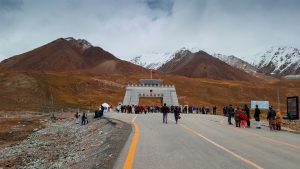An article published by the South China Morning Post on April 27 reported that a feasibility study had deemed the China-Pakistan railway, costing $58 billion, as “worth it.” This news was picked up by various media platforms in Pakistan, India, and the United States, with supporters of the current Pakistani government touting it as a huge success and the revival of the China-Pakistan Economic Corridor (CPEC).
However, upon further analysis and investigation, it has been revealed that this claim is not accurate. China has not expressed any intention to proceed with the plan, nor has any new feasibility study been completed.
The SCMP story was not based on a feasibility study at all, but on a journal article titled “Research on the Investment and Financing Operation Mode of Railway’s Go Global Projects,” which was published in the Chinese Journal of Railway Transport and Economy. This author has a copy of the article in Chinese language.
The article, produced by two staff members of China Railway First Survey and Design Institute Group, a government-owned national survey and design company, stated that the proposed China-Pakistan Railway is currently in the pre-feasibility study stage. It also stated that the railway line would connect Kashgar in Xinjiang, China, to Gwadar in Balochistan, Pakistan, with a total length of about 3,000 km, requiring a total investment of 400 billion yuan ($58 billion).
However, the focus of the article was on the financing mode of the proposed project, rather than a feasibility study commissioned by the Chinese government.
The idea of the China-Pakistan Railway Project was first proposed by former Pakistani President Pervez Musharraf in 2008 to the Chinese leadership. This is also mentioned in another article published in the Chinese journal South Asian Studies Quarterly 2012, a copy of which was seen by this writer. Musharraf’s original proposal was to construct a railway line from Kashgar to Rawalpindi, where it would join Pakistan’s existing railway network and provide access from western China to the Arabian Sea via Gwadar port.
However, the idea never went beyond the pre-feasibility stage due to the difficult terrain of the China-Pakistan border region and the huge costs involved. As a result, there is still no indication by the Chinese government that they have any plans to consider it for a feasibility study.
There are three main reasons why the proposed railway project is infeasible.
First, the railway would need to pass through the hard terrain of the Karakoram region, crossing plateaus, snow-capped mountains, and rivers, with some sections having an altitude of 4,700 meters. The Karakoram Highway remains closed for four months in winter due to snowfall. The only ambitious way to bypass the snow-capped mountains is to build a tunnel under the mountains, which will be very costly, and technically may not be possible.
Second, the proposed cost of $58 billion is too high to be practical, especially considering that the entire CPEC has a total estimated value of $50 billion, out of which only $25.4 billion have been spent so far. The CPEC enterprise is not without financial problems, and Chinese companies are having trouble getting payments, especially for power projects. Under these circumstances, why would China invest $58 billion just for one railway project?
Third, CPEC’s existing rail project sets a gloomy precedent. The Main Line 1 (ML-1) project, the largest project of CPEC, aims to upgrade railway infrastructure in Pakistan from Karachi to Peshawar. The rail project has a value of $10 billion – far less than the China-Pakistan railway, although still substantial. Yet ML-1 has not materialized eight years after the inception of CPEC due to disagreements on financing terms and political instability in Pakistan.
In conclusion, China is not planning to spend $58 billion on the construction of the China-Pakistan Railway project, and no feasibility study for this proposed project has been completed or approved. The original SCMP story even caveats its findings. The article ends by noting that the study’s authors “said their recommendation could help to move negotiations forward” – an admission that the project is currently stalled.
Yet as the narrative got picked up by other outlets, the inaccurate reporting of a journal article without double-checking the story has led to false claims and perceptions about the project.

































